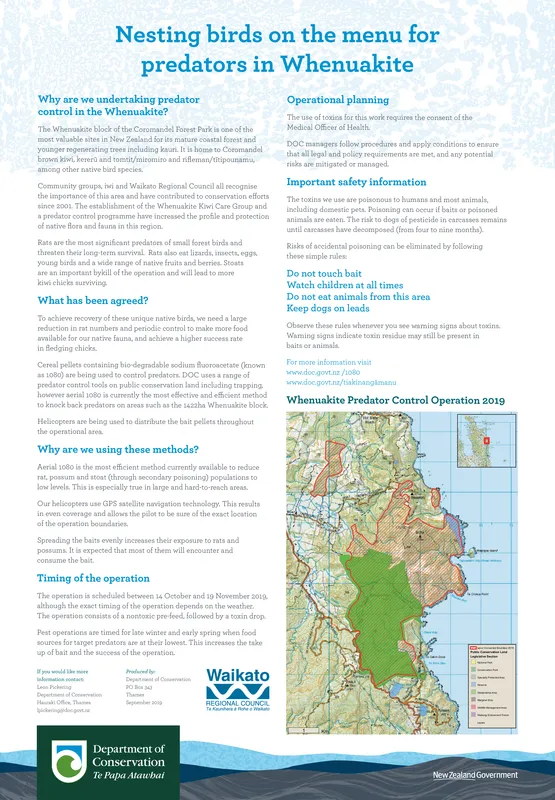Advertisement

-
Published Date
October 18, 2019This ad was originally published on this date and may contain an offer that is no longer valid. To learn more about this business and its most recent offers, click here.
Ad Text
Nesting birds on the menu for predators in Whenuakite Why are we undertaking predator control in the Whenuakite? Operational planning The use of toxinia for this work requires the eonsent of the Medical Officer of 1Health The Whenuskite block of the Coromandel Forest Park is one of the most valusble sites in New Zealand for its mature coastal forest and younger regenerating trees ineluding kauni. It is home to Coeomandel brown kiwi, kererü and tomtit/micomiro and rifleman/titipounamu among other native bird species DOCmanagers follow procedutes and apply conditions to ensure that all legal and policy requirements are met, and any potential risks are mitigated or managed Important safety information Community groups hi and Waikato Regional Coancil all recognise the importance of this area and have contributed to conservation effiorts since 2001. The establishment of the Whenuakite Kiwi Care Group and a predator control programme have increased the prole and peotection of native flora and fauns in this region The toxins we use are poisonous to humans and most animals ineluding domestie pets. Poisoning ean oecur if baits or poisoned animals are esten. The risk to dogs of pesticide in carcasses remains until cascasses have decomposed (from four to nine months). Rats are the most signifeant peedators of small forest birds and threaten theit long term survival Rats also est lizards, insects, eggs young binds and a wide range of native fraits and berries. Stoats are an impostant bykill of the operation and will lead to more lkivi chicks surviving Risks of accidental poisoning can be eliminated by following these simple rales Do not touch bait Watch ehildren at all times Do not eat animals from this area What has been agreed? Keep dogs on leads To achieve recovery of these unique native birds, we need a large reduction in rat numbers and periodie control to make more food available for our native fauna, and aehieve a higher susess rate in Bedging chicks Observe these rules whenever you see seaming signs about toxins Waming signs indicate toxin residue may atill be present in baits or animals For more information visit Ceresl pelets coetaining bio-degradable sodium Buoroacetate (anown as 1080) are being used to control predators DOC uses a range of predator control toels on public conservation land inclading trapping however aerial 1o80 is currently the moet efective and efficient method to knock back predators on areas sach as the 12aha Whenuakite block awww.doc.govt.nz/ho80 www.docgovt.nz/tiakinanglenanu Whenuakite Predator Control Operation 2019 Helcopers are belng used to distribute the bait pellets theoughout the operational area Why are we using these methods? Aerial 080 is the most efficient method earrently available to reduce rat, possum and stoat (through secondary poisoning) populations to lo levels. This is especially true in large and hard-to-resch areas Our belseopters use GPS satellite navigation technology. This results in even coverage and allowes the plot to be sure of the exact location of the operation boundaries Spreading the baits evenly increases their exposure to rats and possums. It is expected that most of them will encounter and consume the bait. Timing of the operation The operation is sebeduled between 14 October and 19 November 201 although the exsct timing of the operation depends on the weather. The operation consists of a nontoxic pre-feed, followed by a toxin drop. Pest operations are timed for late winter and early spring when food sourees for tanget predators are at their lowest. This inereases the take up of bait and the suecess of the operation i Prod Waikato iy ld e m a Le Pchering Detmnt ol Conra Hry Thane d Th Se REGIONAL COUNCL Roaa Department of Conservation Te Papa Atawbai Newzealand Government Nesting birds on the menu for predators in Whenuakite Why are we undertaking predator control in the Whenuakite? Operational planning The use of toxinia for this work requires the eonsent of the Medical Officer of 1Health The Whenuskite block of the Coromandel Forest Park is one of the most valusble sites in New Zealand for its mature coastal forest and younger regenerating trees ineluding kauni. It is home to Coeomandel brown kiwi, kererü and tomtit/micomiro and rifleman/titipounamu among other native bird species DOCmanagers follow procedutes and apply conditions to ensure that all legal and policy requirements are met, and any potential risks are mitigated or managed Important safety information Community groups hi and Waikato Regional Coancil all recognise the importance of this area and have contributed to conservation effiorts since 2001. The establishment of the Whenuakite Kiwi Care Group and a predator control programme have increased the prole and peotection of native flora and fauns in this region The toxins we use are poisonous to humans and most animals ineluding domestie pets. Poisoning ean oecur if baits or poisoned animals are esten. The risk to dogs of pesticide in carcasses remains until cascasses have decomposed (from four to nine months). Rats are the most signifeant peedators of small forest birds and threaten theit long term survival Rats also est lizards, insects, eggs young binds and a wide range of native fraits and berries. Stoats are an impostant bykill of the operation and will lead to more lkivi chicks surviving Risks of accidental poisoning can be eliminated by following these simple rales Do not touch bait Watch ehildren at all times Do not eat animals from this area What has been agreed? Keep dogs on leads To achieve recovery of these unique native birds, we need a large reduction in rat numbers and periodie control to make more food available for our native fauna, and aehieve a higher susess rate in Bedging chicks Observe these rules whenever you see seaming signs about toxins Waming signs indicate toxin residue may atill be present in baits or animals For more information visit Ceresl pelets coetaining bio-degradable sodium Buoroacetate (anown as 1080) are being used to control predators DOC uses a range of predator control toels on public conservation land inclading trapping however aerial 1o80 is currently the moet efective and efficient method to knock back predators on areas sach as the 12aha Whenuakite block awww.doc.govt.nz/ho80 www.docgovt.nz/tiakinanglenanu Whenuakite Predator Control Operation 2019 Helcopers are belng used to distribute the bait pellets theoughout the operational area Why are we using these methods? Aerial 080 is the most efficient method earrently available to reduce rat, possum and stoat (through secondary poisoning) populations to lo levels. This is especially true in large and hard-to-resch areas Our belseopters use GPS satellite navigation technology. This results in even coverage and allowes the plot to be sure of the exact location of the operation boundaries Spreading the baits evenly increases their exposure to rats and possums. It is expected that most of them will encounter and consume the bait. Timing of the operation The operation is sebeduled between 14 October and 19 November 201 although the exsct timing of the operation depends on the weather. The operation consists of a nontoxic pre-feed, followed by a toxin drop. Pest operations are timed for late winter and early spring when food sourees for tanget predators are at their lowest. This inereases the take up of bait and the suecess of the operation i Prod Waikato iy ld e m a Le Pchering Detmnt ol Conra Hry Thane d Th Se REGIONAL COUNCL Roaa Department of Conservation Te Papa Atawbai Newzealand Government
